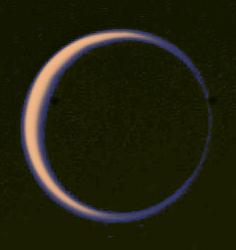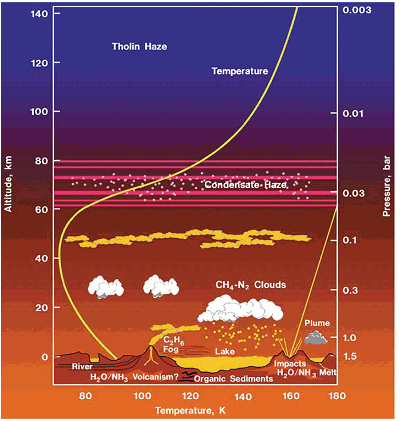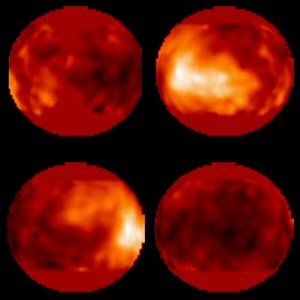This web page's content and links are no longer actively maintained. It is available for reference purposes only. NASA Official: Dr. Paul Mahaffy

Titan: Behind the Orange Haze
Basic Properties

Titan is the second largest moon in the Solar System; with a
diameter of 5150 km (3,200 miles),
it is just slightly smaller than Jupiter's moon Ganymede. Half of Titan
is comprised of water ice and half is comprised of rocky material.
Although considered to be a moon, Titan is bigger than 2 planets
of our Solar System - it is larger in diameter than Mercury and more
massive than Pluto.
The Atmosphere
The surface of Titan is shrouded by a dense atmosphere, comprised
primarily of nitrogen
and methane with traces of argon and hydrocarbons. The organic
(carbon-based) compounds are
formed as the methane is destroyed by sunlight. The result is Titan's
signature orange haze - very
similar to smog on Earth, only thicker.
Titan's atmosphere is actually 50% denser than Earth's, and visible
light cannot penetrate it. As a result, when Voyager 1 flew past in
Novemeber of 1980 and tried to take photographs,
all that scientists could discern from the pictures were thick clouds
and an orange haze.
Scientists hypothesize that Titan's atmosphere is comprised as the
diagram below:

Titan's Atmospheric Layers
The Surface
Titan's surface is a mystery to scientists. They do know it is not homogeneous
- it is not uniform in its composition. There is much debate over
whether or not the surface is
comprised of dry land, oceans of hydrocarbons, or slush.

Recent Hubble Telescope
Pictures of Titan's Surface
The surface temperature is around 94 K (-290 degrees Fahrenheit),
which is too cold for liquid water to exist. In order for liquid water
to exist on Titan, it would have to be thermally insulated underneath a
layer of ice.
What Scientists Hope to Learn
With its methane-rich, nitrogen-based atmosphere and clouds made of
complex organic molecules, Titan possesses conditions similar to the
conditions on Earth before life began.
By studying and understanding Titan's atmosphere, scientists aim to
understand how life
evolved on Earth.
Interesting Links About Titan
- Nine Planets: Titan
- Space Today Online
- For additional interesting information about Titan, search the
ESA website by clicking here
- Radar
Observations
- Touchdown
or Splashdown? Titan Probe May Get All Wet
- New
Detailed VLT Images of the Largest Moon in the Solar System
- A
"Dragon" on the Surface of Titan
- Map and
Movie from Spatially-Resolved 1.6µm Spectroscopy of Titan
- Keck
Telescope images yield movie of Titan's hydrocarbon haze
- Lifting
the Veils of Titan
- Peering
Closer at Titan
- Cassini
sails to Saturn
- New
Titan Image, June 14, 2004
- Cassini
Provides New Views of Titan (July 3, 2004)
- Receding Titan
(July 27, 2004)
- Titan's
Purple Haze Points to a Fuzzy Past
- The
Double Haze above Titan
- Saturn's Moon Titan: Prebiotic Laboratory
- Saturn's
Moon Titan: Planet Wannabe
-
Scientists prepare for space probe's plunge into Titan's atmosphere (October 13, 2004)
-
First Close Up on Titan (October 26, 2004)
-
Scientists elated by Cassini's Titan observations
-
Titan's Complex Surface
-
Titan's Big Surprise
-
Diversity on Titan (October 28, 2004)
-
'Black Cat' on Titan (October 28, 2004)
-
Two Views of Titan's Haze
-
Landing Site for Huygens
-
The day of descent
-
Crunch, squelch or splash?
-
Radar Shows Titan Live and in Color
-
RADAR Surprises from Titan
-
Second space Christmas for ESA: Huygens to begin its final journey to Titan
-
On Top of Titan's Mountain
- Titan's Many Layers
- Spying Titan's Weather
- Titan Surmised (Dec. 20)
- Titan Disguised (Dec. 21)
- European
Space Agency's Huygens Probe Set to Detach From Cassini Orbiter
- Splash, Thud, or Whimper? Cassini's Huygens Probe Rendezvous with Titan
- Cassini
orbiter deploys Titan descent probe
- Timeline of critical upcoming events
- Huygens probe
unleashed on Titan
- Parachuting to Titan
- The descent of Huygens
- Titan Touchdown
- ESA Says Huygens Got a Good Start
- Scientists Ecstatic At Result Of Titan Probe
ACKNOWLEDGEMENTS:
Click to go to top
- Site Developer/Designer: Catherine Micek





